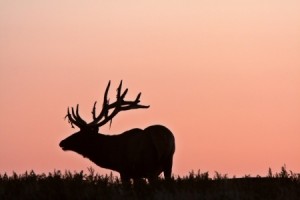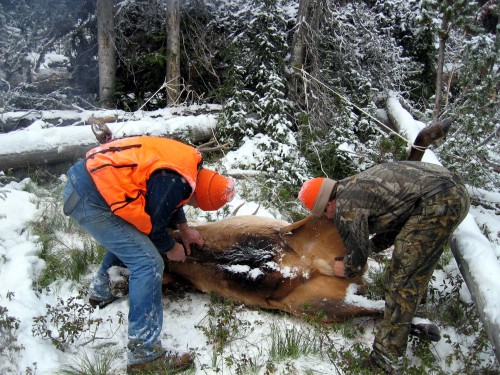 The elk collapsed like a sack of bricks. It’s the end of an exhilarating hunt. My elation is tempered by a feeling of reverence for the life that has been taken. Mine is a poor-man’s hunt on public land and on foot. No horse, mule or OHV. Donning a pack frame, rifle and butchering tools, I head for the most remote tract of forest I can find. My effort has just begun.
The elk collapsed like a sack of bricks. It’s the end of an exhilarating hunt. My elation is tempered by a feeling of reverence for the life that has been taken. Mine is a poor-man’s hunt on public land and on foot. No horse, mule or OHV. Donning a pack frame, rifle and butchering tools, I head for the most remote tract of forest I can find. My effort has just begun.
Now to the task of field dressing and packing out game. Starting at the poop chute, I slip a razor-sharp knife blade just under the skin, making sure I don’t puncture the bladder or gut. I cut a very shallow line of skin along the abdomen, ending at the sternum. Then I return to the anus and separate that and the sex organs from the carcass. After the bladder and intestines are freed from the connective tissue in the abdominal cavity, I tip the carcass over and spill the guts.
The next step is removing the organs from the rib cage. First, I slice through the throat and esophagus at the base of the neck, then go back to the body cavity and open the diaphragm. With a little trimming, I can usually reach inside and pull out the heart and lungs with modest effort. That’s it. The field dressing is done.
Some hunters drag their game on the ground. Some strap it to a heavy plastic sheet and slide it over the ground. Still others use game carriers. Since I hunt in mountainous terrain, strewn with deadfalls, boulders and tree limbs, I bone out and back-pack my game. Although this method demands top physical condition, it allows me to get past a lot of obstacles that will stop game carriers or plastic sliders.
To reduce the weight I remove the hide and separate the skeleton from the meat. After laying out a plastic sheet, I begin carving out muscle groups. The pieces that aren’t neat and tidy go into a pile for hamburger. When you field dress a game animal, you cut out about 40% of its dead weight. When you remove the skeleton, you take away another half.
 Can I haul it out in one load? That depends on the amount of meat, terrain to be crossed, and if I have a hunting partner. If two trips are needed, I cache the meat to be left in a breathable cloth bag, and hoist it into a tree out of reach of scavengers and predators. The rest goes into my pack or strapped onto the pack frame.
Can I haul it out in one load? That depends on the amount of meat, terrain to be crossed, and if I have a hunting partner. If two trips are needed, I cache the meat to be left in a breathable cloth bag, and hoist it into a tree out of reach of scavengers and predators. The rest goes into my pack or strapped onto the pack frame.
It’s a good idea to collect a couple of walking sticks before putting on your pack. They provide balance and extra traction. Putting on the pack can be a challenge. I find it easiest to sit down, strap myself in and put a rock to my feet. At times, I have to roll over and stand up with the aid of my hands and arms.
I’ve packed elk over talus slides, up snowy ridges and through brushy tangles. That’s when I wonder if the elk got the better end of the deal. Hauling an animal out on your back is an ordeal. Torture pretty well describes the hike back to the truck. It takes about a week for the stiffness to leave the muscles and for me to cut and wrap the meat. After it’s all over, what remains are the memories of wild country, wild animals and the primal instincts that came alive that day.
